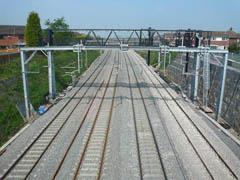
UK: There are signs that the long drought in railway electrification since privatisation may soon be over. Around a third of Network Rail's 15 810 route-km is currently electrified, including 3 220 km at 25 kV 50 Hz and 1 995 km using 750 V DC third rail. Much of the overhead wiring was done in three bursts during the 1960s, 1970s and 1980s, but barely 50 km of track has been energised since 1995.
With growing congestion on trunk routes and concern about environmental and energy issues, passenger and freight train operators have been calling for more electrification, and Network Rail is looking at various options as part of its forthcoming Network Route Utilisation Study. The Department for Transport has been resolutely opposed to discussing electrification, but now the government seems to be getting the message.
In a statement to Parliament on October 29, Secretary of State for Transport Geoff Hoon announced that Minister of State Lord Adonis is to 'chair a national networks strategy group' with representatives from the rail and road sectors as well as the Treasury and other departments. This will look at two main issues: 'how to make best use of the key existing networks' and 'longer-term solutions for the strategic corridors'. The work is to 'be taken forward immediately' and Hoon has asked Adonis to 'report on progress early in 2009'.
Providing just two examples of enhancement, Hoon put 'selective extension of rail electrification' ahead of work to increase motorway capacity. And in his longer-term vision rail was the only mode mentioned. 'We are committed to developing a modern sustainable rail system that supports economic growth, including housing development, and the climate change agenda. New lines have great potential and it is important that we start now to plan for future growth', he explained.
Appearing before the Commons Transport Committee the same day, Hoon said he was 'passionate about developing plans for further electrification on key routes and about assessing the scope for new lines'. Questioned on whether the current economic climate would 'affect the delivery of big capital projects', Hoon said he saw 'no reason why it should', because the Prime Minister and Chancellor of the Exchequer had 'committed to government playing its part in getting the country through the present difficulties'.
However, he emphasised in his statement that 'it is crucial that the case for such investment is underpinned by robust evidence on long-term demand projections and a clear understanding of the capacity of the existing networks, and takes full account of relevant geographical, technical and environmental considerations'.
Among the priority electrification schemes identified by NR are the Great Western and Midland main lines as well as several promoted by Transport Scotland. NR's Director, Mechanical & Electrical Engineering, Steve Yianni told an IMechE seminar on October 30 that the infrastructure manager was looking at acquiring a fleet of high-output trains for a rolling programme. After a ramp-up period, NR could be wiring 650 track-km a year during the 2014-19 control period, and 'this scale of activity could extend for 10 years or more, because of the number of routes required to be electrified'.



















